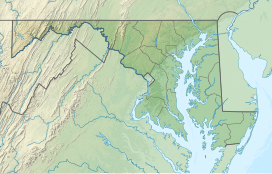| Wye Oak State Park | |
|---|---|
 Wye Oak, September 1929 | |
| Location | Wye Mills, Maryland, United States |
| Coordinates | 38°56′21″N 76°04′51″W / 38.93917°N 76.08083°W |
| Area | 29 acres (12 ha)[1] |
| Elevation | 43 ft (13 m) |
| Established | 2009 |
| Administered by | Maryland Department of Natural Resources |
| Designation | Maryland state park |
| Website | Official website |

The Wye Oak was the largest white oak tree in the United States and the State Tree of Maryland from 1941 until its demise in 2002.[2] Wye Oak State Park preserves the site where the revered tree stood for more than 400 years in the town of Wye Mills, Talbot County, Maryland.[2]
The Wye Oak was believed to be over 460 years old at the time of its destruction during a severe thunderstorm on June 6, 2002. It measured 31 feet 10 inches (970 cm) in circumference of the trunk at breast height, 96 feet (29 m) high, with a crown spread of 119 feet (36 m).[3] It is believed that the acorn that became the oak germinated around 1540. Its largest limb, estimated to weigh 35 short tons (31.5 tonnes) and six feet (1.8 meters) thick, fell earlier, on June 10, 1984.[4] The Wye Oak was still bearing a maturing crop of acorns when it was toppled.[5]
The Wye Oak drew public attention in 1909, when Maryland State Forester Fred W. Besley made the first official measurement of the tree. Ten years later, in 1919, it was featured in American Forestry magazine as the first tree in the American Forestry Association's "Tree Hall of Fame."[6][7] The Wye Oak inspired Besley to found the Big Tree Champion Program in 1925; as a result, in 1940 the American Forestry Association named the Wye Oak one of its first National Champion Trees. By the time of its destruction 62 years later, only one other tree named that year remained standing. The tree faced a loss of a large limb in 1956 that sparked concerns, and another limb fell in 1984 that weighed 70,280 lb (31,880 kg).[8]
The tree fell during a heavy thunderstorm with high winds on the night of June 6, 2002. The tree's exceptionally long life has been attributed to the efforts of park managers, who applied preventive measures such as fertilizer and insecticide as well as extensive pruning, cabling, and bracing of the branches.[5]
- ^ Cite error: The named reference
acreagereportwas invoked but never defined (see the help page). - ^ a b Cite error: The named reference
mdnrwas invoked but never defined (see the help page). - ^ Cite error: The named reference
manualwas invoked but never defined (see the help page). - ^ Preston, Dickson J. (November 1984). "Our Largest Oak Looses a Limb". American Forests. 90 (11): 42, 43, 62, and 63.
- ^ a b Cite error: The named reference
USDAwas invoked but never defined (see the help page). - ^ Cite error: The named reference
mdnr2was invoked but never defined (see the help page). - ^ Cite error: The named reference
packageswas invoked but never defined (see the help page). - ^ Arthur S. Brisbane (June 21, 1984). "MD's Wye Oak is still massive after 35 ton loss". The Washington Post.
